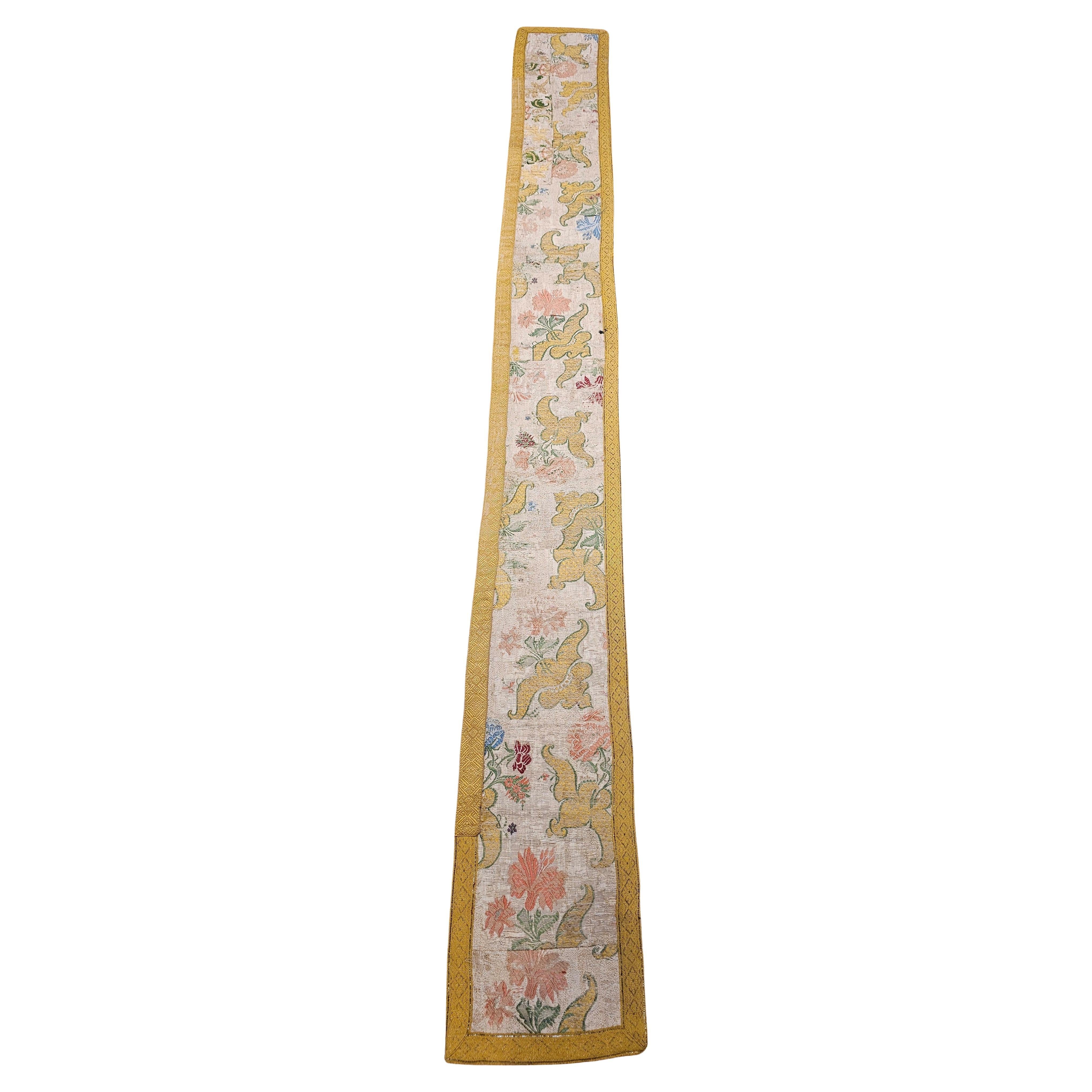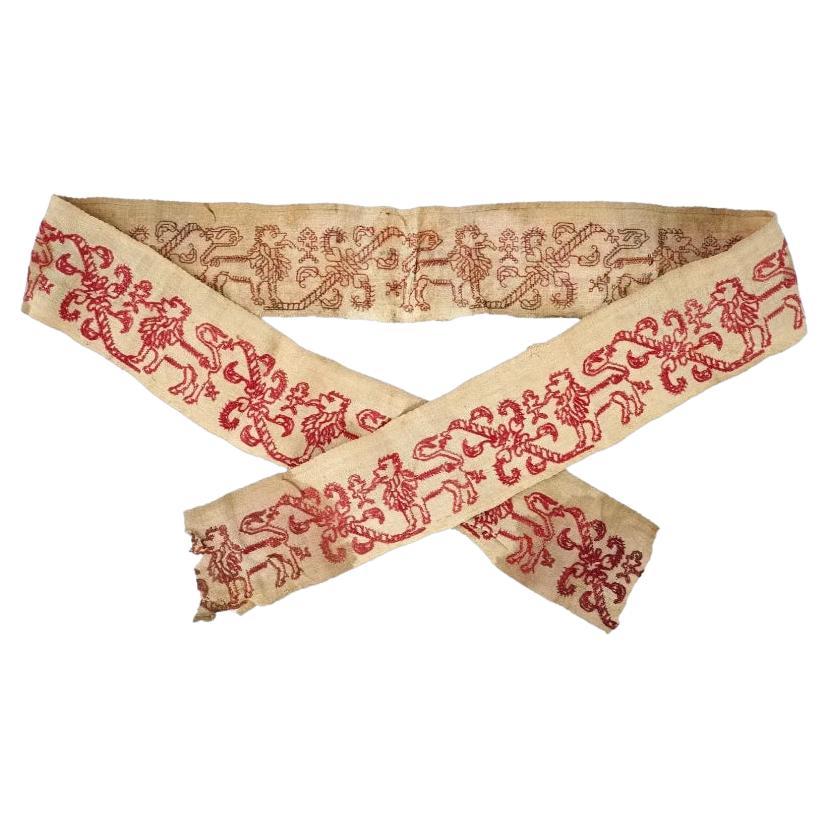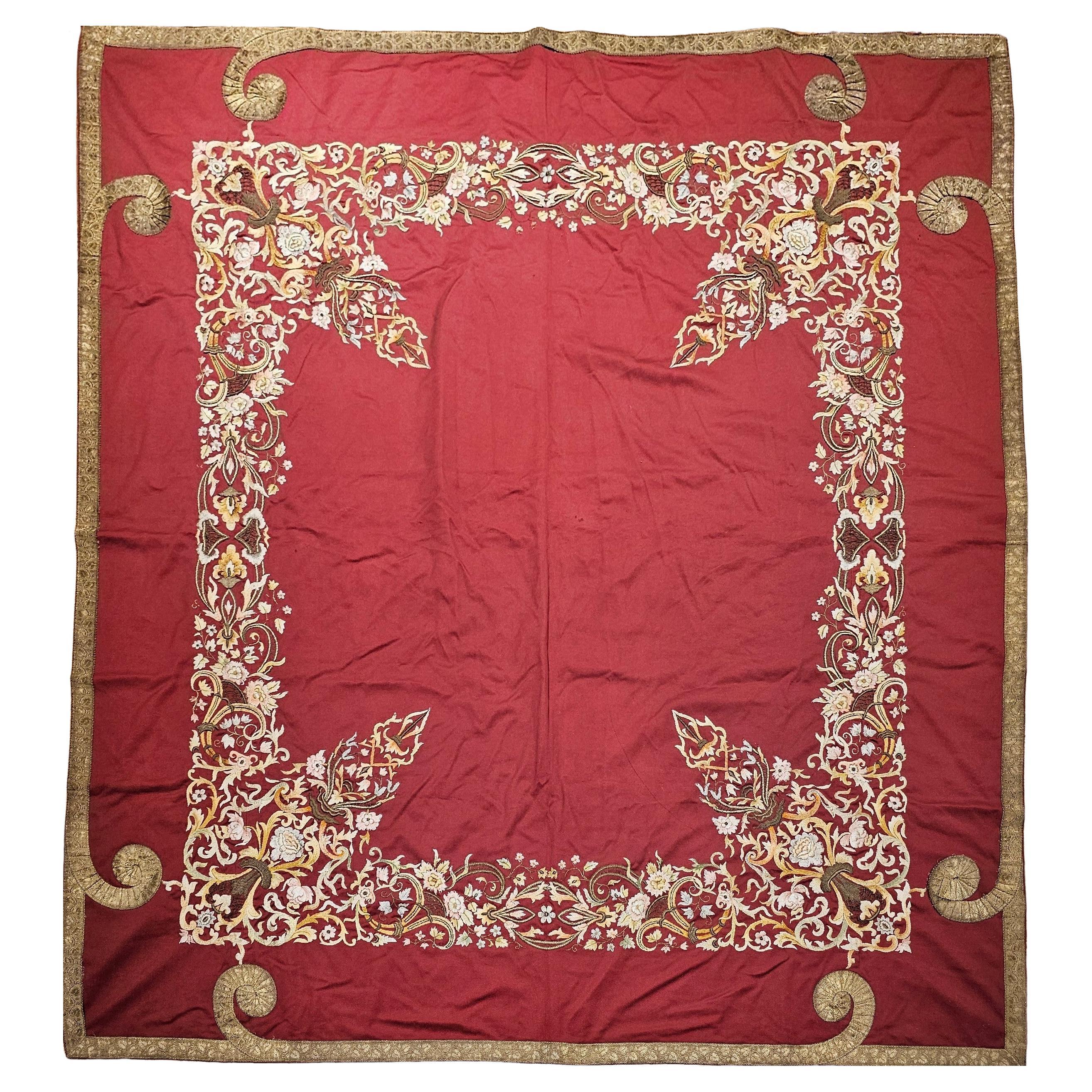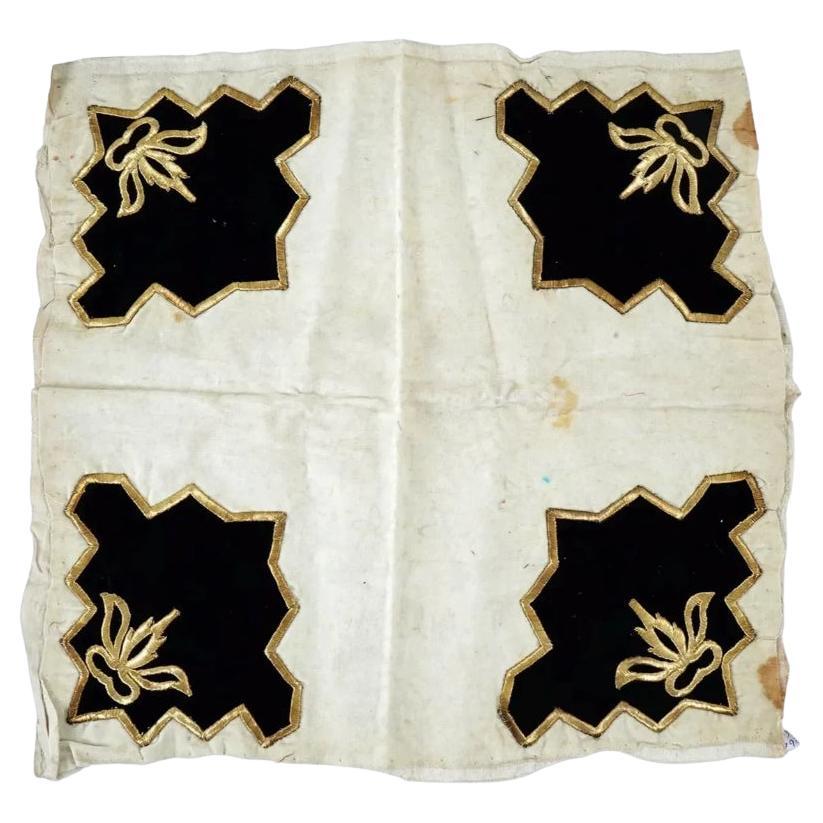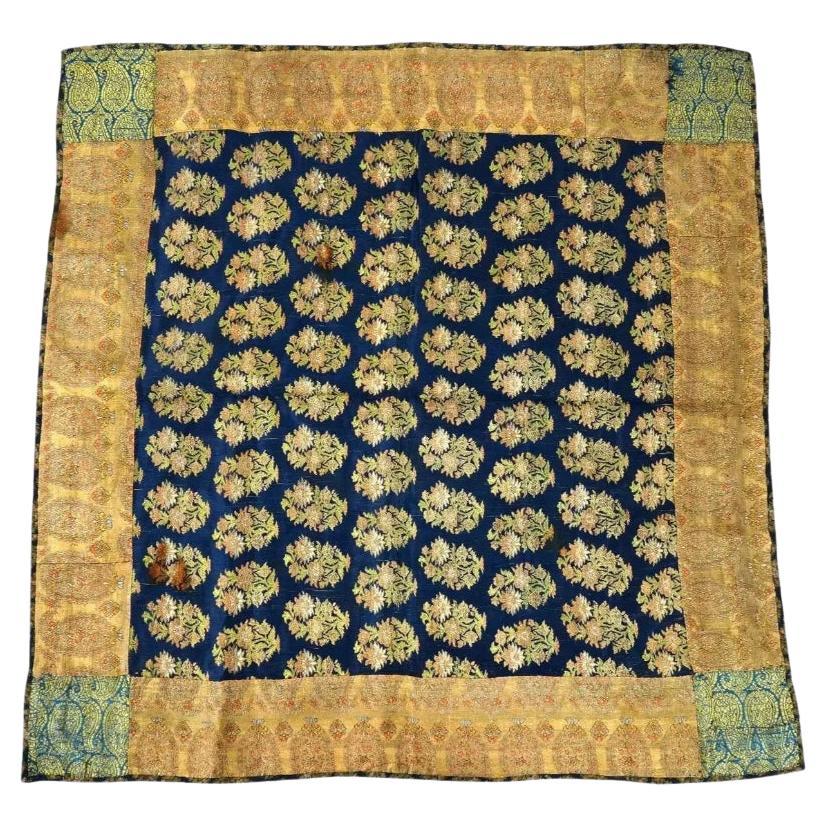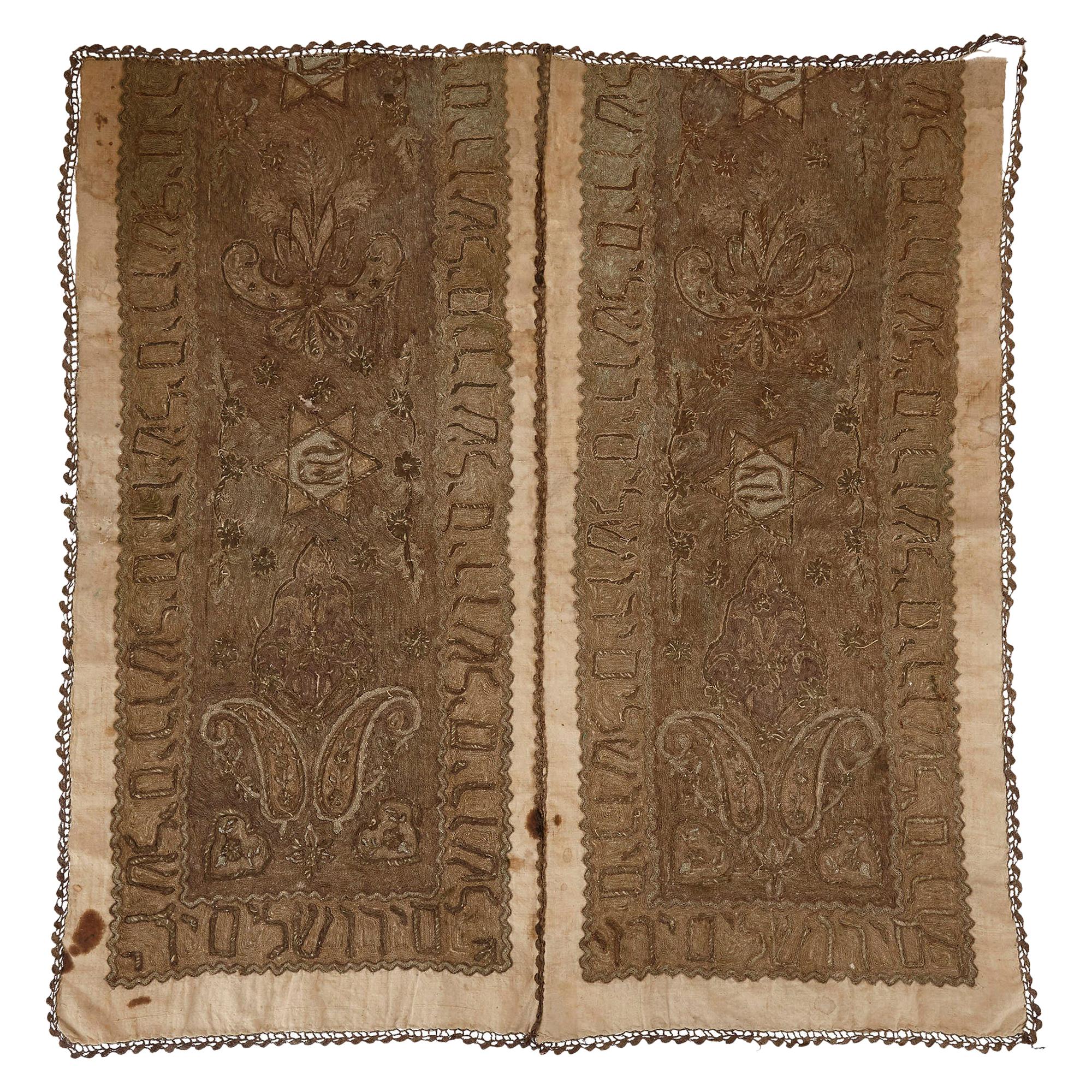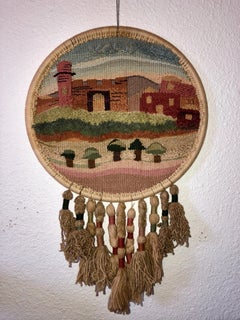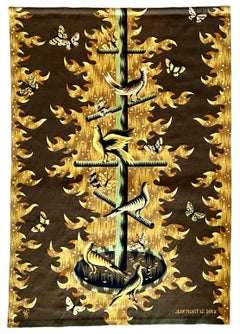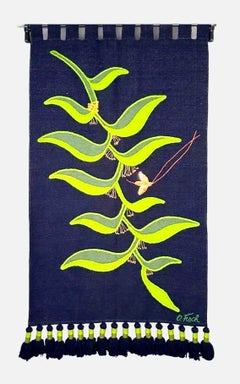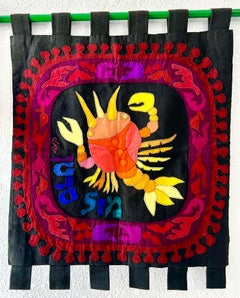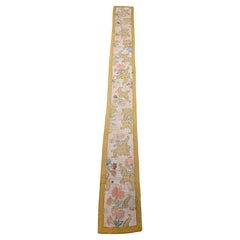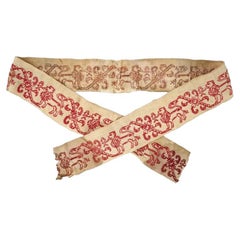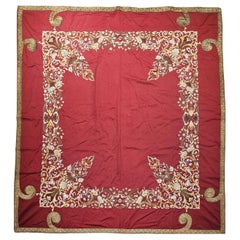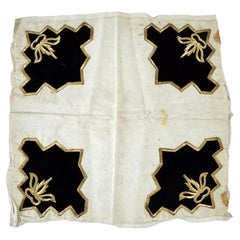Items Similar to Rare Jewish Pre War Woven Gold Textile Embroidered Antique Judaica Tallit Atara
Want more images or videos?
Request additional images or videos from the seller
1 of 7
UnknownRare Jewish Pre War Woven Gold Textile Embroidered Antique Judaica Tallit Atarac. 20th Century
c. 20th Century
$950
£721.36
€824.93
CA$1,327.29
A$1,476.23
CHF 770.84
MX$17,964.19
NOK 9,844.85
SEK 9,232.73
DKK 6,156.74
Shipping
Retrieving quote...The 1stDibs Promise:
Authenticity Guarantee,
Money-Back Guarantee,
24-Hour Cancellation
About the Item
Shpanyer Arbeit, Jewish textile ritual judaic Folk Art
Estimated to the 19th century or early 20th century. there are no markings. It is a hand weaving piece. there are no markings but similar pieces have been in the Bezalel Museum collection and the Israel Museum collection and the Jewish Museum collection in New York city. This appears to be European (probably Russian, German, Hungarian or Polish) It does not appear to be Sephardic or Israeli. It is for a Tallis worn at the neck. It has metallic thread in the embroidery. not sure what material if it is wool or silk as base. There are no Hebrew markings on it. Please see photos.
- Creation Year:c. 20th Century
- Dimensions:Height: 3 in (7.62 cm)Width: 22 in (55.88 cm)
- Medium:
- Movement & Style:
- Period:
- Condition:Wear commensurate with age and use. Refer to photos.
- Gallery Location:Surfside, FL
- Reference Number:1stDibs: LU38214882392
About the Seller
4.9
Platinum Seller
Premium sellers with a 4.7+ rating and 24-hour response times
Established in 1995
1stDibs seller since 2014
1,784 sales on 1stDibs
Typical response time: <1 hour
- ShippingRetrieving quote...Shipping from: Surfside, FL
- Return Policy
Authenticity Guarantee
In the unlikely event there’s an issue with an item’s authenticity, contact us within 1 year for a full refund. DetailsMoney-Back Guarantee
If your item is not as described, is damaged in transit, or does not arrive, contact us within 7 days for a full refund. Details24-Hour Cancellation
You have a 24-hour grace period in which to reconsider your purchase, with no questions asked.Vetted Professional Sellers
Our world-class sellers must adhere to strict standards for service and quality, maintaining the integrity of our listings.Price-Match Guarantee
If you find that a seller listed the same item for a lower price elsewhere, we’ll match it.Trusted Global Delivery
Our best-in-class carrier network provides specialized shipping options worldwide, including custom delivery.More From This Seller
View AllJerusalem Wall Hanging Hand Embroidered tapestry Israeli Craft Judaica Folk Art
By Esther BenSimon
Located in Surfside, FL
This is an artistic weaving depicting the old city of Jerusalem. Signed in Hebrew and dated verso. it is all Hand Woven.
Esther Bensimon is a native of Argentina. She graduated from the Teacher’s College of Yeshiva University in New York City and immigrated to Israel in 1968. She is held in high regard as both an artist and a human being. Perpetually fascinated by the world of art, Esther Bensimon originally fulfilled her yearning to become a part of it by weaving magnificent wall hangings. She was accepted, early in her career, as a member of The House of Quality, the prestigious Jerusalem artist cooperative where she opened her first studio. It is a prestigious venue with sculpture by David Palombo and artists studios Zelig Segal, Ori Resheff, Avi Biran, Menachem Berman...
Category
1980s Folk Art Mixed Media
Materials
Wool, Cotton
Art Deco French Modernist Handmade Aubusson Gobelin Tapestry Jean Picart Le Doux
By Jean Picart Le Doux
Located in Surfside, FL
Jean Picart Le Doux, French (1902 - 1982)
"Au Rendez Vous Des Oiseaux"
Larger handmade wool Aubusson tapisserie
Produced by Maison M. Berthaut Aubusson Atelier, France. Signed Lower left corner woven with firm's monogram and lower right with artists full name.
Bears stitched label attached en verso.
Original documents included with the lot.
Measures 71-1/2" x 50".
Jean Picart Le Doux, born in Paris in 1902 and died in 1982, was a French painter and painter-cartonnier the revival of contemporary flat weave tapestry. He is the son of the painter Charles Picart Le Doux (1881-1959). His first tapestry dating from 1943 after winning the Grand Prix of the theater poster exhibition in the imaging. He met Jean Lurcat and, and Marc Saint-Saëns,and together they founded the Association of painters cardboard tapestry in 1947. In 1950, he comes up with the idea for the Alliance Graphique Internationale, during the meeting with exhibitors of an exhibition of their work in Basel, Switzerland along with two other French designers Jean Jacques Colin and Nathan, and two Swiss graphic designers, Fritz Buhler and Donald Brown. AGI is officially founded November 22, 1952 and Picart Le Doux will be its first president.
Picart Le Doux was a French artist noted for his role in the revival of contemporary hand woven Aubusson tapestry. Picart Le Doux's first tapestry cartoon was a diptych entitled The Four Seasons. Made in 1943...
Category
Mid-20th Century Modern More Art
Materials
Wool
Vintage Handwoven Tapestry Wool Folk Art Rug Weaving Wall Hanging Olga Fisch
By Olga Fisch
Located in Surfside, FL
Olga Fisch ( American 1901-1990)
Hummingbird and Pendant Flower, hand woven and stitched wool and sequins, signed lower right.
Dimensions: 58 x 32 in.
Olga Fisch was born in Hungary, studied in Germany and lived in Morocco and Ethiopia before receiving asylum as a Jewish refugee in Ecuador in 1939. For her Indian-inspired designs, Mrs. Fisch uses natural black and white sheep...
Category
20th Century Folk Art More Art
Materials
Wool
Wool Felt Applique Israeli Folk Art Signed Tapestry Kopel Gurwin Bezalel School
By Kopel Gurwin
Located in Surfside, FL
This depicts a Crab, In Hebrew Mazel Sartan (the Zodiac symbol Cancer, June-July) all made by hand. woven and stitched.
Kopel Gurwin (Hebrew: קופל גורבין) (1923–1990) was an Israeli tapestry wall hanging, painter and graphic artist.
Kopel (Kopke') Gurwin (Gurwitz) was born and raised in Vilna, the capital of Lithuania. He spoke Yiddish at home, but simultaneously studied Hebrew at their school which was part of the Tarbut educational network. Kopel was active in the Hashomer Hatzair youth movement. In the 1930s, as a teenager, Kopel helped his parents with the home finances by working in a suit workshop, there he first encountered the art of sewing.
With the outbreak of the Second World War and the German invasion of Vilna, the Jews were imprisoned in camps and ghettos. Kopel and his brother Moshe were separated from their parents and were put to work in coal mines and peat. Kopel's parents were taken to the Stutthof Nazi concentration camp where they died of typhus within a month of each other. Kopel's 12-year-old sister Chava was turned over to the Germans by a Polish family and murdered.
The brothers were arrested by the Germans, but were saved thanks to the connections of Nina Gerstein, Kopel's drama teacher. They hid in an attic until they were discovered, fled and moved to Riga, where they were caught and sent to the Stutthof concentration camp where they were imprisoned until the end of the war. They were put to work maintaining and cleaning trains and took part in one of the death marches. In July 1946, Kopel and Moshe sailed to Helsingborg, Sweden, as part of operation "Folke Bernadotte", in which Sweden took in ill survivors for rehabilitation. Once he recovered, Kopel worked in a publishing house and later was appointed director of the local branch of the Halutz movement.
In 1950 Kopel and Moshe made aliyah to Israel. Kopel worked as a survey for the Survey of Israel Company. In 1951, he enlisted to the Communication Corps and served as a military draftsman. There he won first prize for the design of the front cover of the Communication Corps bulletin.
With his discharge from the army at 29 he started studying drawing and graphics at the Bezalel Academy of Arts and Design in Jerusalem. Among his teachers were Isidor Ascheim, Shlomo Vitkin, Yossi Stern and Jacob Steinhardt. At the end of his first year of study, Kopel won the Reuben and Sarah Lif Excellence Award in written studies. During his studies he also won additional prizes: In 1956 he won first prize from the Lethem Foundation in California for poster design. Later the same year, Kopel won the Hermann Struck prize for his drawing on the theme of Jerusalem.
In 1957 he won an additional first prize from the Lethem Foundation and second place from the printing company Ortzel for a drawing for a Jewish New Year greeting card. In 1958 he won first prize in a competition to design a poster for Tel Aviv's jubilee.
Two years later he won three other awards: First and third prize for designing a poster for Israel Independence Day, celebrating 12 years of the State of Israel.
Also that year Kopel won first prize for a poster to mark the 25th Zionist Congress.
In 1964 he entered the Independence Day poster competition on the theme of aliyah and won first and second prize. Four years later he again entered the competition on the theme of 20 years of Israel's independence and won first prize. The poster was styled like a Holy Ark curtain with two lions and a menorah at its centre. This poster appeared on the cover of the famous book Jewish Art and Civilization, edited by Geoffrey Wigoder as well as the record Voices of 20 Years, 1948-1968, edited by Yossi Godard. In April 1971 he won first prize in the Independence Day poster competition for the fourth time.
Kopel's Folk Art tapestry won the Israeli Independence Day Poster Contest in 1968
With the completion of his studies at Bezalel Kopel moved to Tel Aviv and was hired by Shmuel Grundman's graphics and design studio. Grundman took him to Europe with him to design and supervise the construction of Israeli exhibition pavilions. During his time at Grundman's he discovered the fibrous felt from which he produced most of his wall hangings. At the 1964 Levant Fair exhibition he used felt stuck onto wooden panels for the first time.
The first felt wall hanging that Kopel produced was intended for the American Cultural Centre in Jerusalem and its theme was the United States Declaration of Independence. The wall hanging, which measured 2.85 X 1.85 meters, was stuck on a wooden panel. Kopel ordered rolls of felt from France and began work on wall hangings based on bible stories. He used a needle, hand sewing small even stitches with black embroidery thread which framed and highlighted every detail in the work, as well as using appliqué. The interior designer, Alufa Koljer-Elem, introduced him to Ruth Dayan who managed the shop Maskit in September 1967 he opened his first solo exhibition at the Maskit 6 gallery, in which 12 wall hangings were displayed.
In light of the exhibition at Maskit 6, Meira Gera, the director of artistic activity at the America-Israel Cultural Foundation, organized an additional exhibition of his works at the foundation's exhibition hall in New York City. The exhibition sparked immense press interest, and was also displayed for a few months at the New York Jewish Museum, from where it travelled throughout the United States.
Followed by the exhibition at the Delson-Richter gallery in Old Jaffa, which was later also exhibited at the Jerusalem Theatre.
Kopel's tapestry "The Time for Singing has Arrived" was printed on a UNICEF greeting card in 1978 and again in 1981.
The Israeli Philatelic Service issued three stamps based on three of Kopel's holy ark curtains and one stamp based on an Independence Day poster he designed.
Kopel's creations decorate a large number of synagogues, public buildings, hotels and private collections which were purchased in Israel and around the world. They have decorated, among others, the walls of the King David...
Category
20th Century Folk Art Mixed Media
Materials
Wool, Felt
Rare Antique Judaica Hanging Bronze Jewish Synagogue or Temple Oil Lamp w Chain
Located in Surfside, FL
Judaica Shabbat Continental Hanging Solid Brass Oil Lamp with Central Six Pointed Jewish Star Shaped Body Dimensions Approx: with Chain 23"H x 8
11 x 8 x 8 chain is 22" long
Antique...
Category
19th Century Other Art Style More Art
Materials
Brass, Bronze
Gobelin In Memory of My Mother, Rare Handmade Polish Tapestry
By Aleksandra Manczak
Located in Surfside, FL
57.5 inches x 57.5 inches
Aleksandra Mañczak (born 1948) is an artist and teacher.
From 1969 to 1974 she attended the Strzeminski Academy of Fine Arts and Design in Lodz, Poland. In 1974 she became an assistant at the Fiber-Art Studio and in 1983 she became the head of the same Fiber-Art Studio.
In 1990 she became an assistant professor
In 1995 she became a full professor (Professor of Art).
From 1993 to 1996 she was the Deputy Rector for Science and Promotion at the Academy.
Artistic Activity:
photography, (since 2001 digital images), fiber-art, soft sculpture, paper-art assemblage, installation (including open-air), and writing about visual art, fiber-art and installation.
She has had one-person shows in 1977, 1988, 1991, 1993, and every year since 1995.
location: Lodz, Poland
The year 1972 was also the time when Stefan Popławski’s (a graduate of Academy of Fine Arts in Poznań) piece was created. His simple Self-portrait is a very important interpretation, made in tapestry (162 x 90 cm), of a photograph from a family album. The artist frequently used famous documentary and historical pictures, as well as stills from the movies made by distinguished directors, and press photos. He transformed these selected “films of reality” into cycles: a series of photography reconstructions, movie “pictures,” old performances (Polish banners) and contemporary events. these works got the impact force of a monumentalized...
Category
20th Century Modern More Art
Materials
Tapestry
You May Also Like
18th Century European Hand Embroidered Silk and Gilt Threads Textile Panel
Located in Barrington, IL
Discover a rare and exquisite piece of European artistry with this Exceptional 18th Century Hand-Embroidered Silk and Gilt Thread Textile Panel. This magnificent piece was artistically crafted by repurposing fragments of what was once a grand hand-embroidered robe or a sacred vestment shawl, giving it a unique history and renewed purpose as a stunning decorative panel.
Created in the 18th century, this textile marvel, even after three centuries, retains its remarkable beauty. The beautiful and brilliant colors of the silk threads endure, showcasing the enduring quality of 18th-century dyes and embroidery. The delicate gilt threads woven throughout the design continue to shine exquisitely under the right light, adding a luminous and regal dimension to the piece.
This panel is more than just a textile; it's a tangible link to a bygone era of elaborate craftsmanship and opulent design. Its rich history and artistic re-imagination make it a truly versatile and captivating addition to any discerning interior. Display it as a magnificent tapestry wall art to celebrate its intricate details and historical narrative, or utilize it as a luxurious table runner to imbue your dining or console space with unparalleled elegance and historical charm. A testament to enduring beauty and masterful hand craftsmanship, this piece is ideal for collectors, interior design professionals, and those seeking to adorn their homes with truly unique and authentic historical treasures.
Dimensions: 10.5" x 90"
Date of Manufacture: Early 1700s
Place of Origin: Europe
Material: Silk embroidery with Gold Threads
Condition: Wear consistent with age and use
The Persian Knot Gallery, SKU 1374
Vintage Handwoven Tapestries, French Aubusson Tapestry, Aubusson Tapestry Pillows, French Tapestry Pillows, Antique Rug Pillows, European Embroidery,18th Century Antique French Tapestry...
Category
Antique Early 18th Century French Tapestries
Materials
Gold
18Th Century Greek Embroidered Textile Fragment
Located in Long Island City, NY
An antique Greek hand embroidered cotton textile tape or fragment. The textile is adorned with a hand embroidered red lion and foliage designs. Circa: late 18th century. Antique European Textiles...
Category
Antique 18th Century Unknown Textiles
Materials
Textile
$600 Sale Price
40% Off
19th Century Ottoman Hand Embroidered Silk and Gilt Threads Tapestry Textile
Located in Barrington, IL
19th Century Ottoman silk and gold thread embroidery textile. The square textile of red cotton is decorated in elaborate silk and gold thread embroidery of arabesques, florals and scrolls enclosed by a wide gold metallic ribbon framing the whole. Created in the 19th century, even after 200 years of use the panel still has beautiful and brilliant colors and the gold threads shine under the right light. Beautiful tapestry textile to decorate the wall or displayed on a table or a bed.
A Sotheby's Auction tag from October 1st of 1993 remains at one corner.
Dimensions: 84” x 84”
Date of Manufacture: 19th Century
Place of Origin: Ottoman, Turkey
Material: Silk and gold thread embroidery on cotton
Condition: Wear consistent with age and use
Ottoman Textiles, 19th Century Ottoman Textiles, Gold Thread Textiles, 19th Century Silk Embroidery Textiles, French Aubusson Tapestry, European Embroidery, 18th Century Antique Ottoman Textiles...
Category
Antique Early 19th Century Turkish Quilts and Blankets
Materials
Gold
19Th Century Turkish Hand Embroidered Velvet Textile
Located in Long Island City, NY
An antique Turkish hand embroidered cotton textile. The textile is decorated with an ornate design representing four black velvet panels featuring a gold threaded foliate scroll orna...
Category
Antique 19th Century Unknown Textiles
Materials
Textile
$180 Sale Price
40% Off
Antique Persian Safavid Hand Woven Velvet Textile
Located in Long Island City, NY
An antique Persian Iranian Safavid dynasty hand woven embroidered velvet textile. The textile is adorned with floral and foliage motifs on a deep blue background, with light brown pa...
Category
Antique 17th Century Unknown Textiles
Materials
Textile
$1,204 Sale Price
40% Off
Antique Embroidery with Hebrew Inscriptions
Located in London, GB
Antique embroidery with Hebrew inscriptions
Continental, late 19th century
Measures: Height 91cm, width 87cm
The wall hanging is crafted from...
Category
Antique Late 19th Century European Tapestries
Materials
Textile
